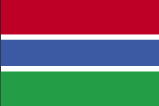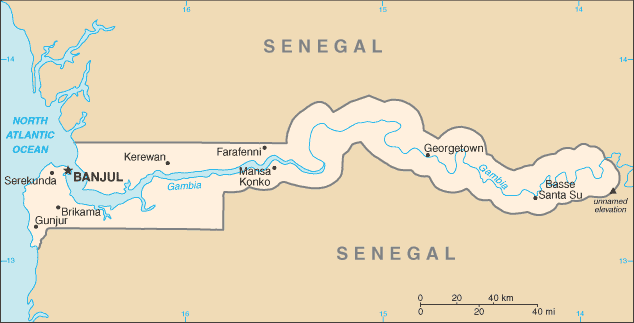|
Gambia, The
|

|
Capital: Banjul
Population: 2,347,706
Brief History of Gambia, The:
The area that is today The Gambia was once a member of the Mali and the Kaabu Empires. The Portuguese were the first Europeans to establish trade with the Kingdom of Mali and The Gambia, but in 1588 they sold the trading rights to Britain.
The Gambia was a major exporter of slaves. It's estimated that 3 million slaves were sold to European slave ships. In 1888 it became an official British colony. Although slavery was abolished earlier in Britain, slavery was abolished in The Gambia in 1906.
The Gambia became a fully independent country in 1965. In 1994, Yahya Jammeh took over the government in a military coup. He has remained in power since.
The Geography of Gambia, The
Total Size: 11,300 square km
Size Comparison: slightly less than twice the size of Delaware
Geographical Coordinates: 13 28 N, 16 34 W
World Region or Continent: Africa
General Terrain: flood plain of the Gambia River flanked by some low hills
Geographical Low Point: Atlantic Ocean 0 m
Geographical High Point: unnamed location 53 m
Climate: tropical; hot, rainy season (June to November); cooler, dry season (November to May)
Major cities: BANJUL (capital) 436,000 (2009), Serekunda
The People of Gambia, The
Type of Government: republic
Languages Spoken: English (official), Mandinka, Wolof, Fula, other indigenous vernaculars
Independence: 18 February 1965 (from UK)
National Holiday: Independence Day, 18 February (1965)
Nationality: Gambian(s)
Religions: Muslim 90%, Christian 9%, indigenous beliefs 1%
National Symbol: lion
National Anthem or Song: For The Gambia, Our Homeland
Economy of Gambia, The
Major Industries: processing peanuts, fish, and hides; tourism, beverages, agricultural machinery assembly, woodworking, metalworking, clothing
Agricultural Products: rice, millet, sorghum, peanuts, corn, sesame, cassava (tapioca), palm kernels; cattle, sheep, goats
Natural Resources: fish, titanium (rutile and ilmenite), tin, zircon, silica sand, clay, petroleum
Major Exports: peanut products, fish, cotton lint, palm kernels, re-exports
Major Imports: foodstuffs, manufactures, fuel, machinery and transport equipment
Currency: dalasi (GMD)
National GDP: $3,496,000,000
** Source for population (2012 est.) and GDP (2011 est.) is CIA World Factbook.
Back to Geography Home Page
